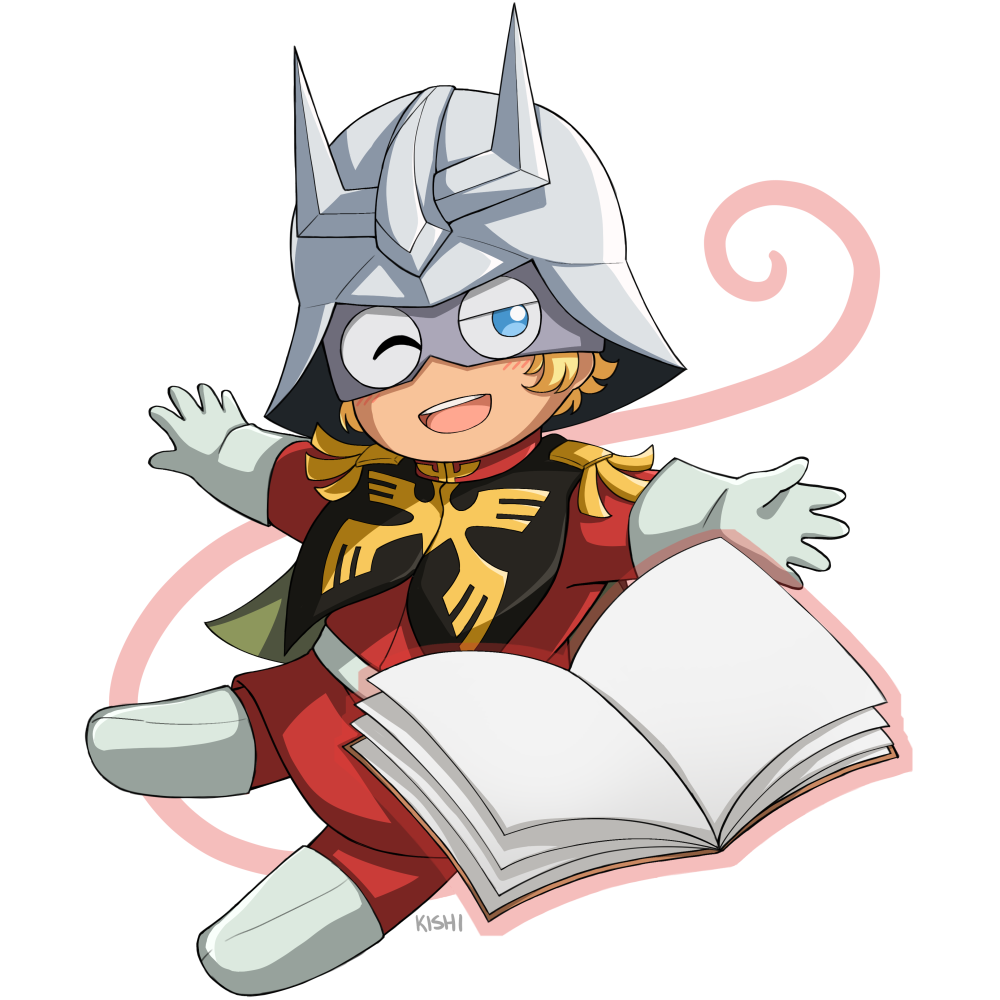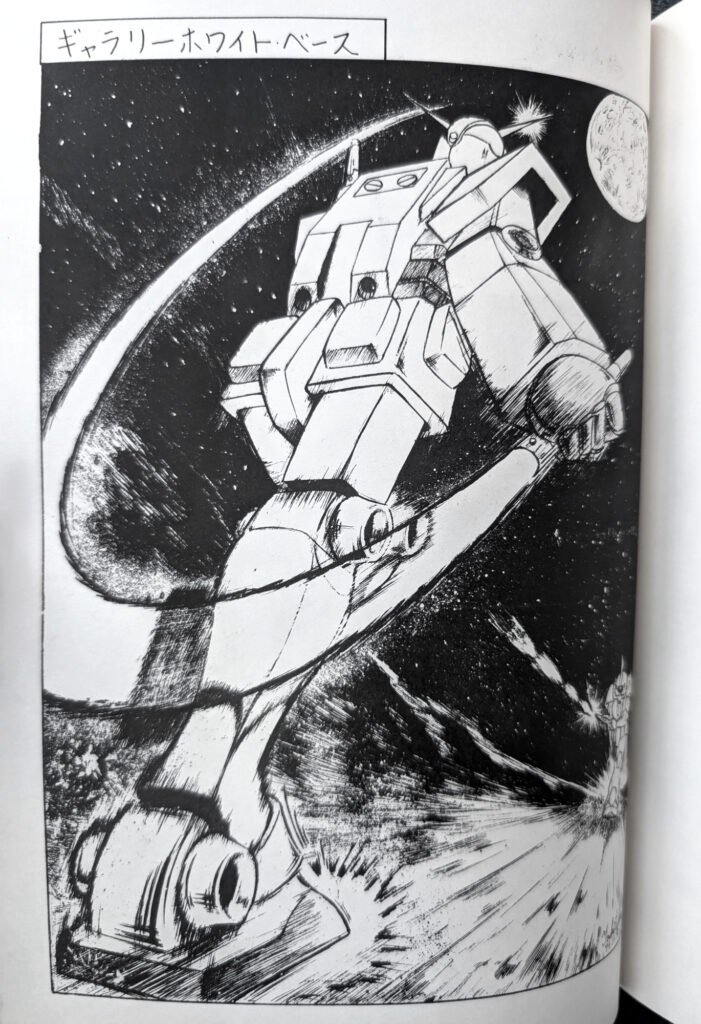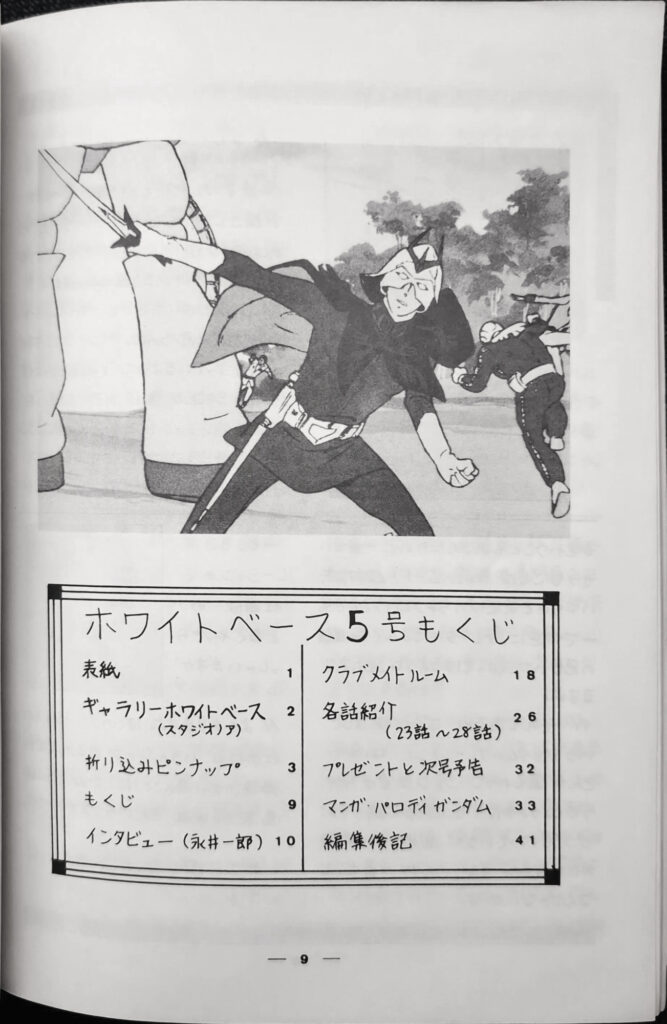
Title: ホワイトベース5号 (White Base No. 5)
Publication Date: January 1, 1980
Subject: Mobile Suit Gundam
Circle: 機動戦士ガンダム F.C. (Mobile Suit Gundam Fan Club)
Artists: Various
While many of the early doujinshi I have covered on this blog are focused on fan made stories and comics about the relationships between characters, White Base No. 5 is more akin to a fanzine, or even a homemade version of a magazine like Monthly OUT. This particular issue features an interview with the late Ichirō Nagai (the show’s narrator and a voice actor of many side characters), fan art, comments from some of the circle members, episode summaries, and a parody comic.
NOTE: As of this article’s publishing, I am in the process of moving and my scanner is packed away in storage. As a substitute, I’ve done my best to take photos of some of the pages in the meantime. I will update with better images as soon as I’m able.
Part 1 in this series includes the gallery, poster, and interview.
Gallery and Table of Contents
[the drawing on the left is credited to Studio Noa]
Fold-out Poster
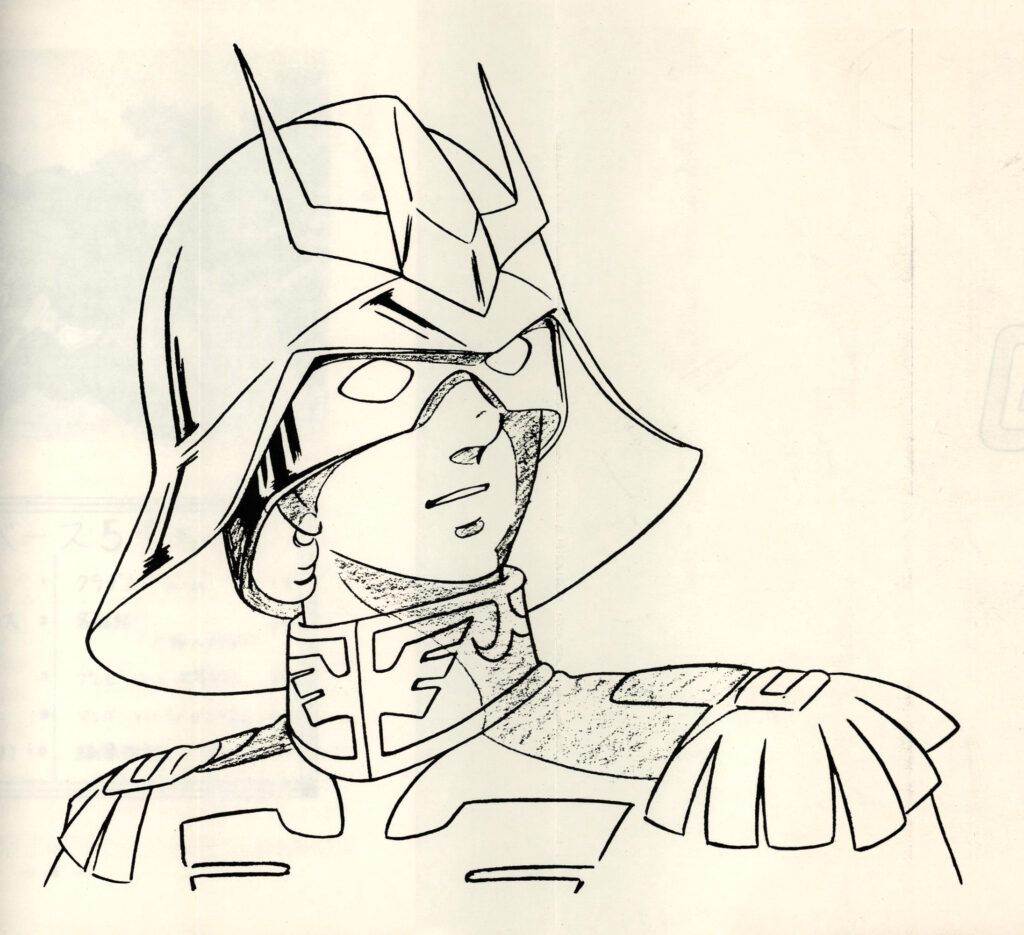
Interview with Ichiro Nagai
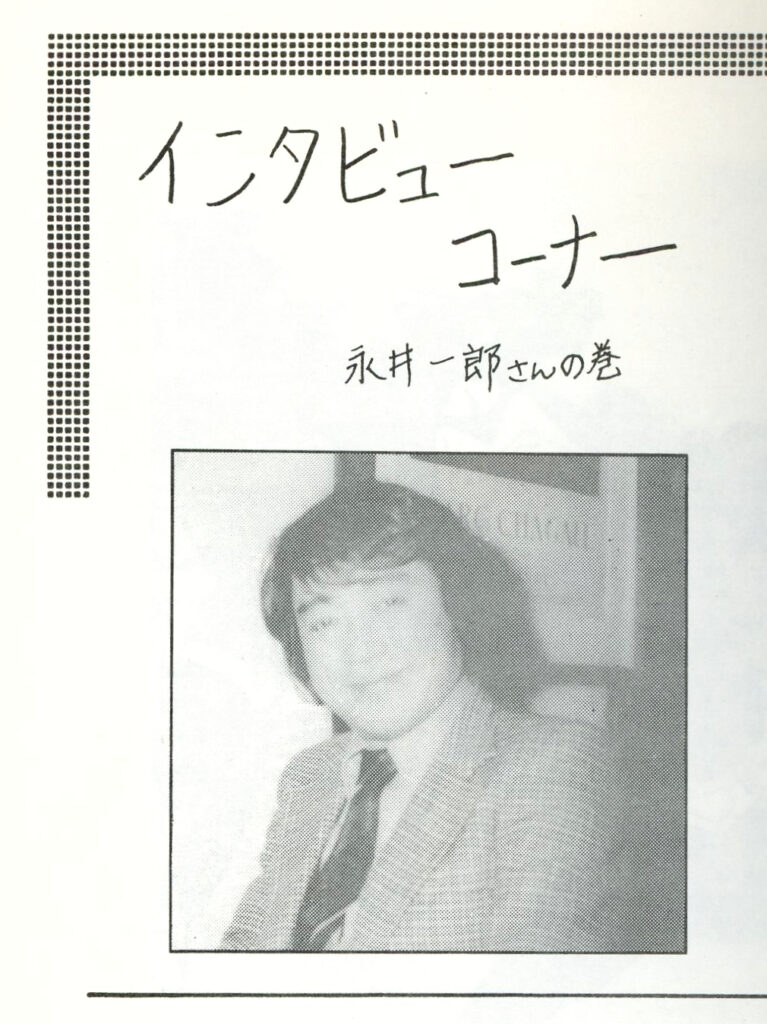
Interview Corner: Ichirō Nagai-san Volume
☆ Narration is…
Q: First, I’d like to ask you about narrators. Narrators tend to take on the responsibility of the entire story (program), don’t they?
N: I think there are many different types of narrators, such as in cultural films that consist entirely of narration, the narration that opens and closes a program, or the narration for the symphonic drama Hi no Tori. Narration sometimes moves the story forward, but what is most important is that it reflects the mood and tone of the work.
Q: On the other hand, the tone of the show can sometimes be determined by the narrator.
N: That’s true. The narration that I do for Gundam is completely different from the narration for Haikara-san ga Tōru. It’s all about how the storyteller relates to the work and how they go about doing so. I think that’s the most important thing.
Q: By the way, you do quite a lot of narration work, don’t you?
N: Yes, I do it quite often and for various jobs, such as educational equipment (cassettes, etc.), cultural films, documentary films, and radio dramas.
☆ You can’t do it hungover
Q: Going off topic, how long have you been working as an actor?
N: I became an actor on stage in 1955. It’s now called the Tokyo Theater Ensemble, but back then it was called the Sankikai Theater Company. I remember joining them that same year. I was there for five years and did stage performances.
Q: So what is the most memorable stage play you’ve ever performed in?
N: This is from a long time ago, but it was the role of Frosch who appears in the third act of Strauss’s Die Fledermaus, performed by Nikikai Opera Company. This left a lasting impression on me. We got a huge round of applause! I also did a play called Bury the Dead at the Sankikai, and it was very well-praised, so it left a lasting impression on me as well. And then there was Honboku Marchen that I did in May of this year (1979).
Q: So when did you start seriously working on voice acting?
N: It must have been around 1956. It was a live broadcast of Superman. Since it was a live broadcast, mistakes were obvious.
Q: But instead of being scared, you felt a sense of tension.
N: It’s not good for your nerves, you know. You can’t do it hungover.
Q: So after that was dubbing movies?
N: Yes, there definitely were a lot of dubbed foreign films. It was just around the time that Channel 10 (now TV Asahi) started broadcasting, which seemed like a channel specializing in foreign films since they showed so many. I did a crazy amount of them.
Q: So, are there any works that you were glad to be a part of?
N: Yes, Wishbone from Rawhide. Well, that’s a major work, so it’s memorable. It’s a Naniwabushi*, if you like, an American Naniwabushi. It’s not that difficult to express or understand. It seems to fit Japanese sensibilities quite well. So it was easy for me because I was able to do it without having to focus on being a foreigner or an American.
[*Naniwabushi is variety of sung narrative popular during the Edo period]
Q: After that, you were in a lot of films, right?
N: I was in quite a lot of movies for a while. I think it was about 7 or 8 years ago that anime started to become much more popular. Before long, I was only doing anime work, and I was so busy with anime that I didn’t get many voiceover requests for foreign movies. I was forced to become an anime person.
☆ I was relieved. And so…
Q: How did you get started in animation?
N: Let me think….If you don’t count when I was a regular, then I started with Atom [Tetsuwan Atom]. I think my first regular role was in Big X. I only remember the professor though. Next was Kaizoku Ouji. That one left a big impression on me. Furuya-kun (Tōru Furuya-san) was still in elementary school at the time.
Q: What was it like?
N: Let’s see, for me, that was the production that made me decide to fight against my old ways as an actor. It’s a bit of a bad way to put it, but it felt like I was making a comeback. Up until then I had been working in a very reserved manner, but with Tora Fugu* I had to change my ways to do my job…that’s the way it was. I was relieved. I think that he (Tora Fugu) dispelled my doubts, which is why I decided to move on to anime.
[*The name of the character Nagai played in Kaizoku Ouji]
Q: Since then, you’ve had a lot of roles in anime. Does that mean Tora Fugu left a strong impression on both the viewers and the people involved in the production?
N: You might be right. I’ve been playing a lot of roles since then. I wouldn’t know how many I’ve done unless I count them properly, but I think it’s about 50, just counting those that are regular and semi-regular.
Q: Besides Tora Fugu, what other anime roles do you remember?
N: Going backwards from more recent ones, I liked Dyce from Conan [Mirai Shounen Conan], Peppino from Sanzenri [Haha wo Tazunete Sanzenri], and Doraneko from Piccolino no Bouken [Pinocchio Yori Piccolino no Bouken]. And I also liked Gakioyaji from Robokko Beeton. Peter Rabbit from Rocky Chuck [Yama Nezumi Rocky Chuck], and Alphonse in Devilman were so silly and I loved them.
Q: So you’re saying that your work ranges from serious to gag. By the way, about Captain Dyce from Conan…
N: Which one does he belong to? I think he’s quite serious. That is to say, he’s a man who lives a very proper life, and he doesn’t live his life like a joke at all. You can see in how he’s portrayed that the more seriously he lives, the more eccentric he seems. That’s the kind of human image he portrays, and it’s different from a comedy. I didn’t think of him as a gag character. I thought of him as a decent human being, a serious human being. But even if I played him that way, an eccentric guy is still eccentric. As for comedy roles, I’d say Gakioyaji and Alphonse. And then Gael (Choujin Sentai Baratack).
Q: Among them, Professor Alfonse seemed to be the most destructive, so how did you play him?
N: It’s about how nonsensical you can be. You have to give it your all. If you do it half-heartedly, it’s grating. You have to really take the initiative to do it. That’s why there aren’t many young people who can do comedy. You need to be able to take the initiative and do it with determination.
Q: By the way, how many years has it been since you started playing Namihei from Sazae-san?
N: It’s been 10 years already. The animation has changed in that time. At first, the heads were very small and close to the original, but now they’re bigger and rounder. For the first two or three years, it felt like I was trying to create something, but if you keep doing that too much, it won’t have longevity. So now I just do it as if I’m breathing easily. Since he [Namihei] is like the greatest common denominator for men of that age, I remove all extremely simple ways of speaking from myself and just calmly let it flow.
☆ Symphonic drama has potential!
Q: Changing the subject, I’d like you to talk about symphonic dramas.
N: About that, we were planning to celebrate Aoni’s* 10th anniversary, and since there are a lot of anime fans, we thought we would do a simple play with songs put to scenes from anime to entertain them. However, we decided that it would be better to have something with a little more depth, but we were all too busy to be able to put on a proper performance. Since we’re not a theater company, it’s difficult for everyone to get together. So we thought about doing a radio drama, and Shibata Hidekatsu-kun wrote Onanamenjo and we tried it out. It turned out to be more interesting than we expected, so then we did Tsugaru Yuki-onna and that led to Hi no Tori. It’s unbelievable that a two-and-a-half-hour epic could be interesting without the stage moving at all. To tell you the truth, the reason it works is because your imagination makes it move… Even if the stage doesn’t move, the images the actors create move in the audience’s heads. So the image you create in your head is stronger than just following what’s shown in front of you. You create your own world, something very powerful to you, through your imagination… That’s why we took it (the time).
[*Refers to the Japanese talent agency Aoni Production, founded in 1969]
Q: In that sense, there may be a different Hi no Tori inside each person…
N: Yes, there are different interpretations of Hi no Tori, so that’s what makes it art. Whatever the viewers imagine, it will be realized in its own way, so I think it is a genre with great potential. I think it is wonderful that it was invented.
Q: That’s true. It goes beyond just being a radio drama.
N: It surpasses radio dramas, and is much more interesting than a boring, moving play. On the other hand, the viewer’s imagination expands without being restricted by what is shown in front of them.
Q: That said, maybe it’s a little different, but is it related to Kabuki?
N: I think it has more to do with Rakugo than with Kabuki. Rakugo is a world where a storyteller narrates alone, without any lighting or equipment. (The audience) has to imagine it for themselves. That’s why Rakugo performers and storytellers end up in genres like that. It’s that feeling you get when you’re doing something like that as a group. So I think it’s closer to genres like Rakugo or Kōdan than it is to radio dramas or other theatrical stuff.
Q: So there’s still more to look forward to from now on…
N: Yes, I think there are a lot of possibilities.
Q: Any plans for another symphonic drama in the future?
N: Well, I don’t really know. But, if it can somehow become established as a genre, then I would like to see it take root.
[the following are comments written below the interview]
Held November 9th at Chagall
When we started our interviews with the voice actors, we first asked Ichirō Nagai-san, who is the narrator and core of the show. We would like to humbly express our gratitude to Ichirō Nagai-san, who answered each of our questions carefully and patiently.
In addition, we will give the shikishi [autograph boards] we received during this interview to five lucky winners. Please see page 32 for details.
Handwritten Interview
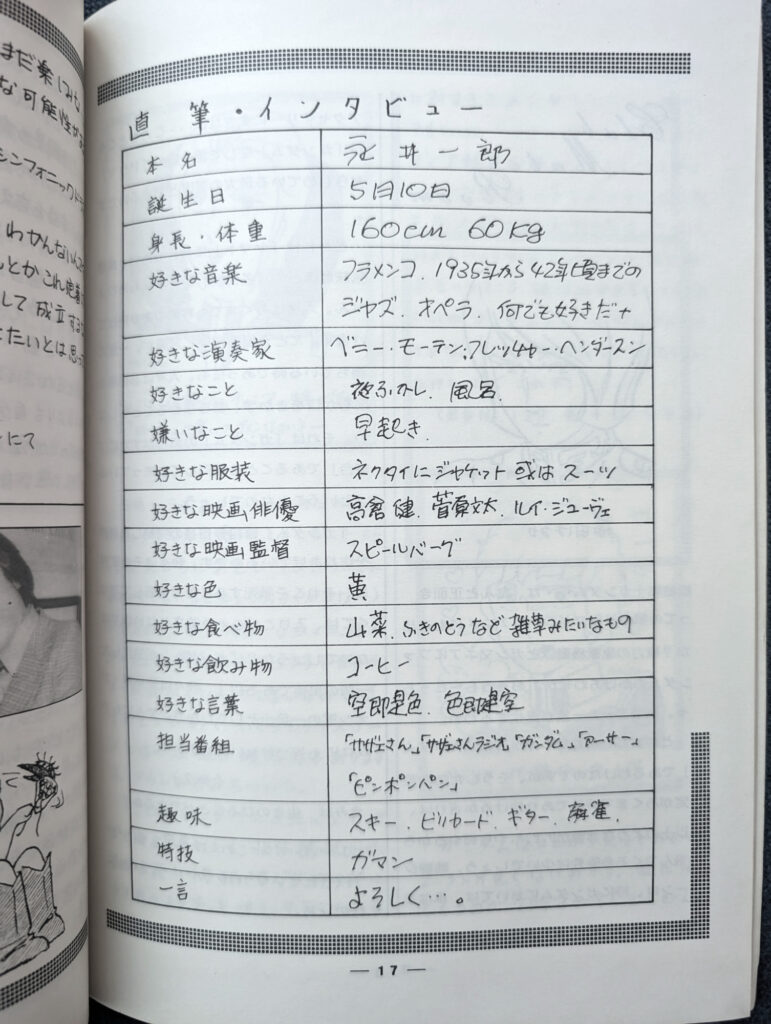
| Real name | Ichirō Nagai |
| Birthday | May 10th |
| Height and Weight | 160cm 60kg |
| Favorite music | Flamenco, jazz from 1935 to 1942, opera, I like them all |
| Favorite performer | Benny Morten and Fletcher Henderson |
| What I like | Staying up late, taking baths |
| What I don’t like | Waking up early |
| Favorite clothes | Tie and jacket or a suit |
| Favorite movie actor | Ken Takakura, Bunta Sugawara, Louis Jouvet |
| Favorite movie director | Spielberg |
| Favorite color | Yellow |
| Favorite food | Wild plants, butterbur sprouts, and other weed-like plants |
| Favorite drink | Coffee |
| Favorite phrases | “Emptiness is form”, “Form is emptiness” |
| Programs involved in | Sazae-san, Sazae-san Radio, Gundam, Arthur, Ping Pong Pan |
| Hobbies | Skiing, billiards, guitar, mahjong |
| Special skills | Patience |
| Final word | Nice to meet you… |
